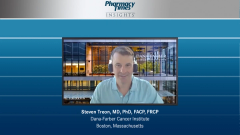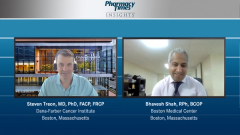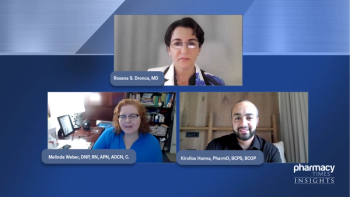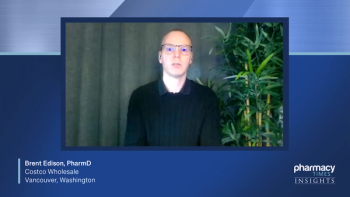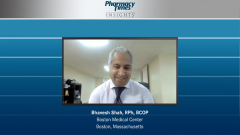
Novel Therapies for Waldenstrom Macroglublinemia
What pharmacists need to know about the adoption of novel targeted therapies for Waldenstrom macroglobulinemia into regular clinical practice.
Episodes in this series

Bhavesh Shah, RPh, BCOP: If you go into the NCCN [National Comprehensive Cancer Network] guidelines, there are a lot of regimens there for first-line. We’re going to discuss how you design a regimen for the first line, maybe starting with how a lot of these patients will present with hyperviscosity and how you treat those patients initially. I know plasmapheresis is involved and there may be a regimen that may be more effective with specifically hyperviscosity. I wanted you to share your perspective on that.
Steven Treon, MD, PhD, FACP, FRCP: It’s a good one. From a clinician’s perspective, having the genomic data is very helpful in this regard. But when you’re dealing with an oncological emergency, such as hyperviscosity syndrome, you might not have the genomics in front of you, so you want to deal with the immediate problem at hand. Getting the patient plasmapheresis is extremely critical. Luckily, hyperviscosity only presents itself in about 10% of all patients. It’s relatively uncommon, but you need to act on it. Bing-Neel syndrome when somebody is presenting with CNS [central nervous system] changes requires immediate therapy. Sometimes you can have bulky disease because of the tumor. That requires therapy. There are different ways that we go about treating patients based on how they present.
In general, for patients who present with bulky disease, we prioritize lymphoma-like regimens, like bendamustine with or without Rituxan [rituximab] initially. We always worry about Rituxan. This is a place where the pharmacist can play a big role, because you want to check the IgM [immunoglobulin M]. If somebody has a high IgM, like over 4000 mg/dL, you don’t want to throw that patient into a hyperviscosity crisis. Because the IgM can go up abruptly in about half of all patients. We were the first to describe that. It’s a bystander effect of Rituxan. It turns on the immune cells that then make cytokines, like IL-6 [interleukin 6], and then goose up the tumor cell to make more IgM. You want to be really careful when you give somebody Rituxan if they have Waldenstrom macroglobulinemia with a high IgM level. That’s really important to keep in mind. For the first cycle or 2, we’ll usually give bendamustine alone and then add in the Rituxan. If you’re dealing with somebody who’s going to get a bendamustine/rituximab regimen, keep that in mind.
In general, for CNS disease, we’re prioritizing BTK [Bruton tyrosine kinase] inhibitors these days. They’re small molecules and get into the CNS space. We’ll obviously talk more in a bit about BTK inhibitors. Fludarabine has a unique role in getting into the CNS space. Otherwise we tend to deprioritize it because of our concern over secondary malignancies, which we see a lot of with fludarabine in the Waldenstrom patient population. If you really want to get that IgM down quickly, you’re going to do your plasmapheresis and then think about how you can get the IgM down quickly. Depending on somebody’s genetics, we’ll either prioritize BTK inhibitorsor proteasome inhibitors, which luckily are good drugs. They get the IgM down very fast. They’re not good at taking out bulky disease, which is why we’ll use bendamustine then and we’ll use a proteasome inhibitor if we’re thinking more about IgM-related problems.
Bhavesh Shah, RPh, BCOP: I want to clarify this for some our pharmacy colleagues. Would you say that you may actually see a patient cycling through bendamustine and then a proteasome inhibitor or vice versa? And I think there’s a finite number of cycles that you also may give. If it’s a bendamustine/rituximab regimen, there are 6 cycles.
Steven Treon, MD, PhD, FACP, FRCP: That’s a good point. The pharmacist can play a big role here. With bendamustine, we typically only use 4 cycles. It’s very effective. We see similar levels of activity as 6 [cycles], but we don’t get that burnout of the marrow. We don’t see the prolonged cytopenias that can sometimes happen. That’s important for our pharmacy colleagues to be aware of. Of course, they should also be aware of the fact that for older patients with reduced eGFR [estimated glomerular filtration rate], we tend to also decrease the dosing of bendamustine. I’m sure most folks are familiar with that. And the Rituxan is added in once you feel safe from the IgM perspective. That’s typically when you see that the IgM is under 4000 mg/dL.
It’s interesting with proteasome inhibitors because it depends on the regimen that you use. Most times these days, we use bortezomib [Velcade]. It’s Important for the pharmacist to know that we’re scared of neuropathy when it comes to bortezomib, which is why we don’t use it as much. We tend to use subcutaneous bortezomib. Depending on the acuity, if you have somebody with hyperviscosity and you’re trying to get that IgM down, you might do twice weekly for the first cycle. But then we try very rapidly to go to once weekly and use subcutaneous dosed bortezomib, because patients with Waldenstrom are at a higher risk of getting treatment-related neuropathy, even more so than we see in myeloma and other diseases. That’s because many of them have autoantibodies against their myelin sheath of their nerves, so there’s already the tendency for neuropathy in many of these patients. It’s quite common to have to either hold bortezomib therapy or even stop using it with these patients because they’re very fragile when it comes to neuropathic complications.
Bhavesh Shah, RPh, BCOP: That’s a great point. It may also be an option where a patient may be a candidate for another agent based on the neuropathy that they have or the higher incidence that we think that they’re going to have because of the twice weekly bortezomib that they might not be able to get.
Steven Treon, MD, PhD, FACP, FRCP: You mentioned the number of cycles. The pharmacist should also keep in mind that the goal of therapy when it comes to these patients is to relieve symptoms and get the IgM down and hemoglobin up. We’re not treating patients to CR [complete response]. That’s not our goal, because it’s an indolent lymphoma. This is where many times things arise when people have this notion that the goal of therapy is to get to a CR. We seldom ever get to CRs, even with chemoimmunotherapy. We’re talking CR rates of about 5%, or maybe 10% on the high end. That’s not the goal of therapy. It’s to relieve the symptoms that brought that patient to their oncologist.
Bhavesh Shah, RPh, BCOP: That’s a great perspective. As pharmacists, we’re trained to also look at number of cycles and time to response, even when you see things like very good partial response and complete response as being things that are used as markers—especially in other diseases where we know that there’s maybe deepening of response that happens with some of these therapies that somewhat cross over from one malignancy to another.
Transcript edited for clarity.
Newsletter
Stay informed on drug updates, treatment guidelines, and pharmacy practice trends—subscribe to Pharmacy Times for weekly clinical insights.

